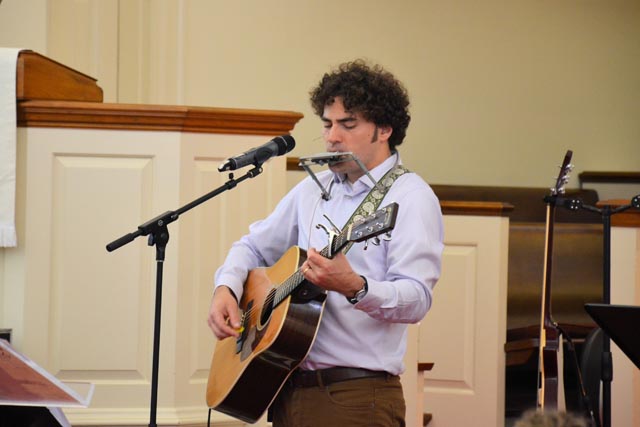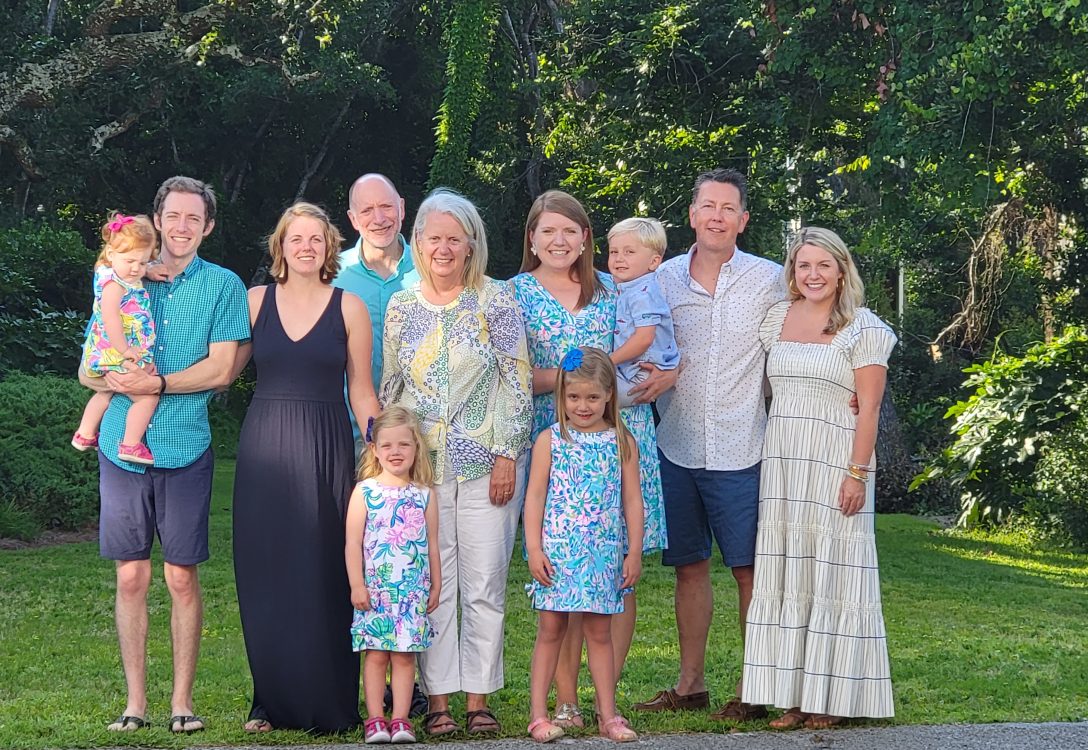
I have been dreading this day since the first time I met Drew Willson. I knew at some point, Drew and his wife, Shea, and their children Kyrianne and Halley would be leaving us. Another assignment from the Virginia Conference would arrive.
It doesn’t seem possible that he has been at Trinity for three years. This is a confirmation that time truly does fly.
When I first met Drew, I thought this guy is like Tom Hanks in the movie Big. Except Drew was Tom Hanks on steroids. Drew was always in motion. Lots of physical energy to be burned like the great comic actors Phil Silvers, Don Knotts, and Tim Conway.
He quickly gave his office—his touch, his feel. Books and musical instruments dominated.
I wrote a story about him for Westham Life magazine. A good part of the article focused on Drew’s first solo album, Inviting Storms To Town. My ears liked what I heard. To my surprise, this wasn’t some Christian folk or rock album. It was real, heartfelt music. Songs carefully crafted, instruments in the backing tracks just right, and lyrics that told stories.
Drew found his way into his work at Trinity. There was a learning curve. At times, that curve was a bit choppy, a bit testy, but I think that is part of a preacher’s life.
Everyone has an opinion about public education, and everyone has an opinion about preachers too. One Sunday, a preacher might be three for three, and the next Sunday, the preacher strikes out.
Sometimes in the pulpit, Drew’s passion, emotions created a stir. That stir might rub us the wrong way. Perhaps, a preacher isn’t truly doing his or her job if they don’t rub us the wrong way once in a while. Maybe it is the chosen topic, maybe it hits too close to home, and it jolts us. I seem to recall that Jesus could rub people the wrong way too.
Being a preacher’s kid, I think those experiences became woven into Drew’s own fabric. I sense Drew was acutely attuned to those communities where his father served. Those experiences became stories. Maybe in those stories Drew was blueprinting his future.
While they had a few early moments of clashing, I don’t think I have ever been around two more gifted musicians than Charles Staples and Drew. When paired with a piece of music they are passionate about— look out! In an entirely different setting, their collaborative Christmas caroling showcase for Pub Theology at Ardent Craft Ales was priceless.
Unlike me, Drew has unbelievable recall from his seminary experience. About the only thing I remember from my master degree work was how painful the statistics course was. His passion for the gospel is extraordinary. He can readily cite assorted topics, insights from professors, and the technical aspects of theology.
Like all of us, Drew is vulnerable. Part of working through the Unstuck consultation hit him hard. One morning session at the Roslyn Retreat Center was really tough. After lunch break, our paths crossed as we were heading back to our meeting room. I sensed his confidence had been slammed. I stopped and told him that I loved him.
Not sure, but I think he sold out the Tin Pan where he staged a solo concert as a fundraiser. Every age demographic from Trinity was at that show. His opening song was a cover of Brian Wilson’s “Love and Mercy.” I think those two words are a big part of Drew’s daily living.
His love and mercy showed, when he rode over to Don Pierce’s hospital room with a guitar. Drew sang to Don during his last days on earth. One of the tunes he performed was“Estrellas en las Montanas”. This gentle song appears on Drew’s second album and was dedicated in memory of Don.
I have no idea what this experience at Trinity has been like for Shea, Kyrianne, and Halley. Families of preachers have a learning curve as well. My guess is that transition isn’t flawless. But, I’ve never seen two cuter children than Kyrianne and Halley. Their eyes sparkle with curiosity.
Shea has her gifts too—writing. She was instrumental in helping us with the revamping of the Trinity Advent devotional book. That first year, she pulled scripture passages together, and took on the tough job of editing every submission.
On October 22, her book, Exactly as You Are: The Life and Faith of Mister Rogers, will be released. Amazon is already taking pre-orders.
I will always cherish the conversations I’ve had with Drew about music. I can’t sing or play any instrument, but as I rapidly age, sometimes a song will cause tears to rise up in my tired eyes. Drew’s second album Ritual Matters does that for me. I am no music critic or expert, but I don’t believe I have heard a better collection of songs. No clunkers on this recording, each song has merit.
Musicians have unique hearing. They hear in a different orbit. But, I also appreciate Drew’s listening skills.Once, he helped a family plan a large and emotionally charged funeral. Somehow, Drew helped the family accomplish a celebration of life.
Drew brings his own personal energy to the Children’s Moment in our traditional worship services. Earlier this spring, Drew used a picnic blanket to illustrate a point related to exclusion and inclusion. In this setting, Drew appears natural, at ease, and the beauty is found in the balance to connect not only with the children, but the adults too. Often, it is humor that is the connector sparked by his interaction with the children.
Both Larry and Drew were helpful in providing resources for me when I was given the privilege to pinch hit in the pulpit. Their expertise was always available. Each of our ministers is gifted in delivering a sermon.
In Drew’s last sermon at Trinity this morning, my brain grabbed hold of his use of the word tension. Lots of tension in our world today. Preachers cast a wide net with their sermons. There is tension in that toss, but I sense our real opportunity to learn comes from that tension. That give and take, that push and pull, is woven with a balance in Drew’s sermons. Additionally, I think Drew has learned from that tension while serving Trinity.
As I stated earlier, I have been dreading Drew’s departure. My brain has been working overtime to find just the right words for saying goodbye. Thanks to Timothy White, I might have found them.
At the conclusion of Mr. White’s book, The Nearest Faraway Place, he shares the following prayer. Some sources cite its anonymous origin to a wall in an old inn in Lancaster, England.
Give us, Lord, a bit o’ sun
a bit o’ work and a bit o’ fun;
give us all in the struggle and sputter
our daily bread and a bit o’ butter;
give us health, our keep to make,
and a bit to spare for other’s sake;
give us sense, for we’re some of us duffers,
an’ a heart to feel for all that suffers;
give us, too, a bit of song
and a tale and a book to help us along,
an’ give us our share o’ sorrows’ lesson
that we may prove how grief’s a blessin’.
Give us, Lord, a chance to be
Our goodly best, brave, wise and free,
Our goodly best for ourself and others
Till we all learn to be sisters and brothers.
I will miss you Drew, Shea, Kyrianne, and Halley, and I will pray for you as your next chapter unfolds.



